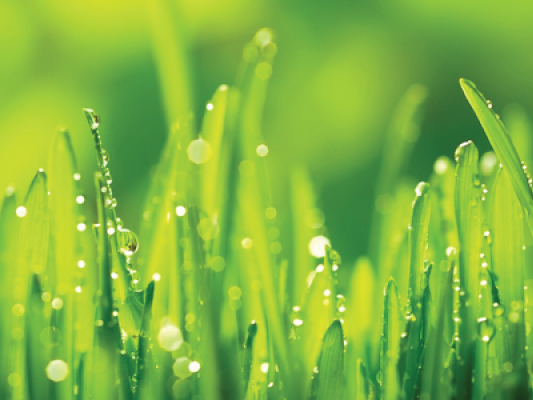When there isn’t sufficient rain your lawn will need supplemental irrigation to keep it healthy and green. While you do the have the option of letting a lawn go dormant during the driest of months, some water is still necessary to keep the crowns of the turf grass plants alive.
How much water does your cool season lawn need during the growing season? It depends on your goals, but generally about one-inch of moisture per week is ideal and should keep your lawn green and growing. How do you know if your lawn is getting enough water? You can measure your sprinkler output and make a few calculations to get close.
Measure output:
Set up three to five rain gauges (or pie tins or like containers) throughout the lawn area. This will measure the amount you have applied and help you to determine the coverage.
Turn on the sprinkler or irrigation system for a measured amount of time. You may need to only run for 10 minutes, but depending on your supply (measured in gallons per minute or GPM), your hose, valves and sprinkler, you may need to run the water for 20 or 30 minutes to get a sufficient reading.
Measure the amount of accumulated water from the duration of the watering.
Calculate your output. If you measure 1/4″ of water accumulation over 30 minutes, you will need to water for two hours to get one inch of water (1/4″ divided by 1″ = 4 x 30 minutes = 120 minutes or two hours).
Create your schedule:
Now that you know your watering equipment’s output you can set up a schedule that fits your lifestyle. According to the sample calculation, you’ll need to water for 2 hours per week. If you can fit in three waterings for the week at approximately 40 minutes, or four waterings for 30 minutes that would be best.
You may find that if you water for too long at one time you create puddles and water will run off the lawn. Avoid puddling, as the soil can’t absorb any more water given the rate you are applying it and you’re being inefficient and wasting water. It may be that you need to water for 20 minutes, change areas and then water again for another 20 minutes.
If you decide that you don’t want to water a full inch per week, follow the math and reduce your watering for 1/2″ to 3/4″ of water per week. Depending on the weather, falling below 1/2″ of water per week could result in the lawn going dormant. Keep in mind, it is easier to keep a lawn green than to make it green. A lawn that has gone dormant will need four times as much water to bring it out of dormancy.
Watering Equipment:
Nelson Oscillating Sprinkler
Available at: www.amleo.com
If you don’t have an in-ground irrigation system, an oscillating style sprinkler is ideal as it mimics natural rain fall. We prefer models with a heavy metal base which minimizes the potential for movement. These sprinklers are not only ideal when watering new grass seed but also for established turf. They cover a large area and sprinkling over a longer period of time allows the water to soak in, avoiding puddling.
Impulse style sprinklers generally come with a flat metal base or a spike that is inserted in the ground. The rotary sprinklers tend to not distribute water evenly across the area, causing dry and/or saturated areas.
Connecting multiple sprinklers together may not be feasible depending on your water pressure and volume. Each additional sprinkler uses available volume, decreasing the overall output of each sprinkler. If you plan to connect multiple sprinklers, measure your output to ensure you’re getting enough water for each configuration you try.
Timers are very helpful to make sure you apply enough water and avoid over watering, particularly if you’re not going to be right near the sprinkler to monitor. Use a battery powered digital timer (available at AM Leonard or home stores) to set your sprinkler to run for the desired amount of time based on your output measurements. If you use the manual style timer that does not require a battery, measure your output to ensure the timing is accurate – these manual timers “estimate” time based on assumed rate of water flow and not actually on time.
Additional watering tips and advice:
- Water in the early morning hours (4 to 9 am) to allow the moisture to soak in without evaporating. Excess moisture will evaporate as the morning sun heats up.
- Avoid late evening or overnight watering, as extended periods of moisture in the lawn may contribute to disease when the proper environmental conditions exist.
- It is preferable to water less frequently and for longer periods of time to get the moisture further into the soil. Watering daily for 5 minutes is not as desirable as watering two or three times per week for 15 or 20 minutes (based on your output measurement and schedule).
- Shaded areas or lawn areas nearer to or under trees may require more water to compensate for the moisture the tree will absorb. In dry/shade areas you’ll never practically be able to water enough to make both the tree and lawn happy – the tree wins nearly every time.
- Irrigation systems are a great tool to help manage the turf. Be aware of the output of the nozzles or rotors in your system and measure the output to dial in your timing. Pop up nozzles put out more water in the area requiring less time per zone than do rotary style heads.

